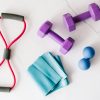Eating a balanced diet with GLP-1s is essential. GLP-1 (glucagon-like peptide 1) is a hormone which enhances feelings of fullness and slows digestion, which can reduce appetite and support weight loss.
However, it can also mean losing interest in food and turning to easy, convenience options. Over time, that can cause nutrient deficiencies, low energy, and other health issues. Eating well while on GLP-1 can help you maintain your health, preserve muscle, and build sustainable habits for when you stop the medication. When your appetite is reduced, it’s even more important that every meal counts. Choosing nutrient-dense foods helps prevent muscle loss, deficiencies, and fatigue while supporting your overall wellbeing and weight goals.
Include plenty of high-fibre foods such as fruit, vegetables, wholegrains (like wholemeal bread or pasta), beans, and pulses. Fibre supports digestion, helps prevent constipation, and keeps you feeling fuller for longer, which can complement the effects of GLP-1 medications.

Protein (found in meat, poultry, fish, eggs, beans, and lentils) is crucial for maintaining muscle mass, especially if you’re eating less overall. Without enough protein, you may lose muscle instead of fat. The NHS recommends adults aim for at least 150 minutes of moderate activity (e.g. brisk walking) or 75 minutes of vigorous exercise (e.g. running) per week, which can also support muscle maintenance.

In terms of each meal, using what is known as the ‘T plate’ model can be a useful way of ensuring each meal is balanced and provides you with adequate nutrition.
½ plate non-starchy vegetables (e.g. broccoli, peas, carrots)
¼ plate lean protein (e.g. chicken, fish, eggs, beans)
¼ plate carbohydrates (e.g. rice, pasta, potatoes, bread)
Many people find having small, regular meals, instead of relying on sugary or fatty snacks (like crisps or chocolate), helps maintain energy levels and meet nutritional needs.
In summary, adequate nutrition while taking GLP-1 medications is vital to prevent deficiencies and muscle loss. Using the T-plate model, eating small and balanced meals, and prioritising fibre and protein will help you stay nourished even with a reduced appetite. Establishing these habits now will also make it easier to maintain your healthy weight once you’ve stopped taking GLP-1.
Disclaimer: I am a Dietetics student sharing general nutritional information for educational purposes. This post is not a substitute for personalised medical or dietetic advice. Always consult your GP or registered dietitian for individual guidance.




